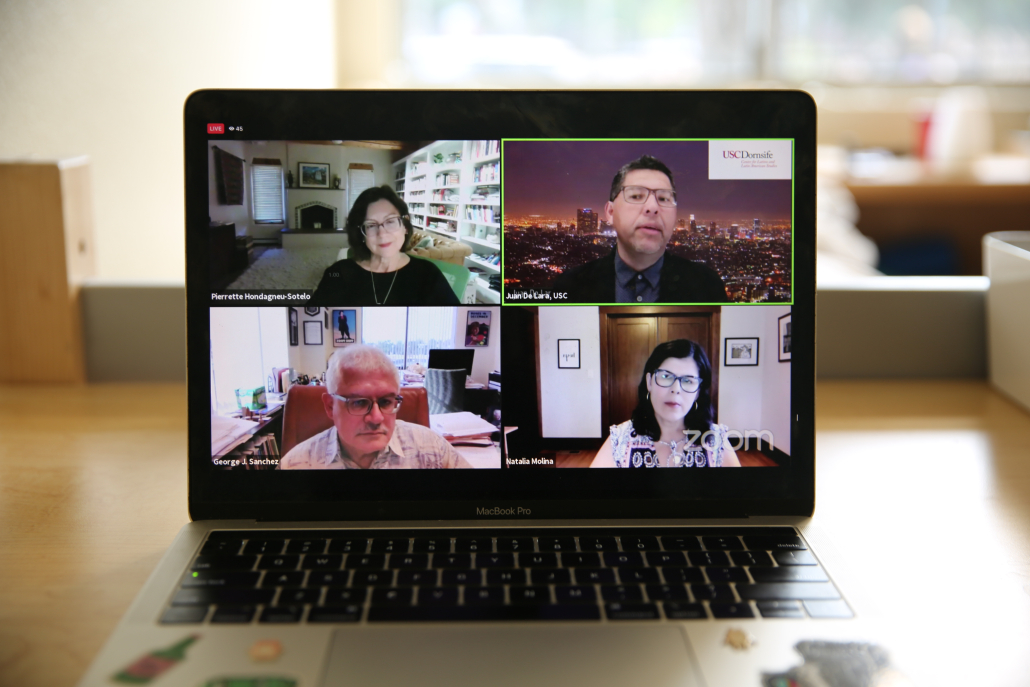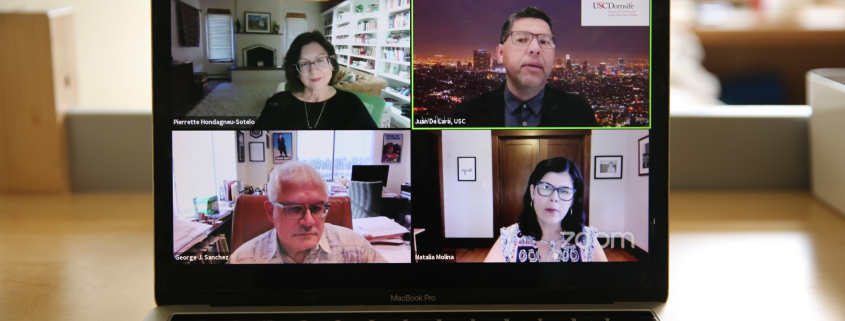Professors share Latinx stories

In honor of Latinx Heritage Month, the USC Dornsife College of Letters, Arts and Sciences and Center for Latin American and Latinx Studies hosted Latinx Stories of Los Angeles Wednesday. In the Facebook Live event, three speakers — distinguished professor of American Studies & Ethnicity Natalia Molina, professor of Sociology Pierrette Hondagneu-Sotelo and professor of American Studies & Ethnicity and History George J. Sánchez — gathered for a discussion moderated by Associate Professor of American Studies and Ethnicity Juan de Lara on their respective books chronicling the histories of different Latinx communities in Los Angeles, from Echo Park in Central L.A. to Watts in South Central.
Molina’s “Place-making at the Nayarit: How a Mexican Restaurant in Los Angeles Nourished its Community” centers on the role of one Mexican restaurant in supporting the local community in Echo Park and providing a space for Mexican immigrants — who were usually seen as “invisible” laborers in the city — to reclaim their voices and find belonging. Sánchez’s “Boyle Heights: How a Los Angeles Neighborhood Became the Future of American Democracy” traces the neighborhood’s history, starting from the early 20th century, and spanning decades in Boyle Heights’s journey from a multi-racial and ethnic area populated by Japanese, Jewish, African Americans and other groups to a community reconfigured by an influx of undocumented immigrants and the departure of other groups.
An L.A. neighborhood undergoing dramatic change was also the focus of Hondagneu-Sotelo’s book “South Central Dreams,” co-authored with distinguished professor of Sociology and American Studies & Ethnicity Manuel Pastor. “South Central Dreams” explores how a historically important African American neighborhood transformed into a predominantly Latinx community over the past 40 or 50 years and the implications of such a transformation on the day-to-day lives of residents.
Following introductions, the speakers jumped into a conversation about the changing nature of “Latinidad,” or what it means to be Latinx, fueled by the interactions and connections between Latinx and other racial groups in communities.
Hondagneu-Sotelo shared a snippet South Central’s history. During the 80s’ and 90s’, residents in neighborhoods such as Watts faced job loss, deindustrialization and street violence and Black families, specifically those with the means to, moved to the suburbs. Meanwhile, first-generation Mexican and Central Americans settled in the area for its affordable housing and job proximity. In the same vein, Sánchez reflected on the parallels between Boyle Heights and South Central in the gradual process of integration between Latinx and other ethnic and racial groups and how it shaped the Latinx experience and identity in Boyle Heights. First-generation immigrants in Boyle Heights in the early 1900s also often stayed apart from other racial groups, Sánchez said. The labor unions and schooling system became key in bringing together and creating connections between people of different races.
“That didn’t mean that Boyle Heights didn’t go through very difficult periods,” Sánchez said. “The periods that I talked about [were] Mexican repatriation followed by Japanese American internment during World War II. People are watching this happen to their neighbors [and] to their classmates, and they end up with a civil rights tradition that emerges in Boyle Heights.”
The speakers also shared their thoughts about their works’ place in Latinx history and scholarship, and their impacts on understanding L.A.’s complex landscape. Sánchez said their books all portrayed L.A. as a Latinx city and explored Latinx experiences where changing communities welcomed new residents to their neighborhoods, a perspective that differs from those of the past.
Molina added that their books also explored L.A. as a racialized city. Looking at the similarities the Latinx experience has with other racial and ethnic groups’ experiences in L.A. is a way to bring the different groups together on common causes.
“To me, the message of these three books is a message of hope,” Molina said. “We may have different racial and ethnic experiences, but we do understand there are commonalities in terms of access to health care, access to education, how we experience the pandemic. This is a very important moment to have this message of hope and common cause, as we see the inequalities that the pandemic has completely brought to the forefront, as we go to elect a new mayor, as we just went for a recall.”
Given that Latinx communities hold a strong position population-wise in L.A. and, thus great political power as well, Pastor — who jumped in for Hondagneu-Sotelo in the middle of the event — emphasized the importance of multiracial organizing and citywide coalitions going forward. Pastor said Black and brown organizing seeks to find common ground on shared issues and to link to greater progressive movements. Black organizers and community members in South Central rely not only Black votes but also on labor and Latinx votes. Similarly, Latinx political figures carefully consider their relationship to the Black political establishment and organizing efforts.
“Latinos in South L.A. have developed the skill in building coalitions on a face to face, neighbor to neighbor basis as have Black people in South L.A.,” said Pastor. “That is an important skill we need citywide.”
The event concluded with De Lara expressing his gratitude for the accomplished Latinx scholars at USC working on issues that transcend disciplines. De Lara also encouraged the audience to read the books featured from the afternoon.
In a separate interview, Molina spoke on what she hopes the participants of the event take away from the conversation.
“I hope that people have a more informed and diverse sense of what it means to be Latino,” Molina said. “In dominant media, we think about Latinos as workers, maybe just immigrants, and don’t really see their lives. I think these books give you a rich history of how Latinos have been integral in terms of what it means to be a good neighbor, what it means to protest, what it means to shape democracy, what it means to participate in politics.”

